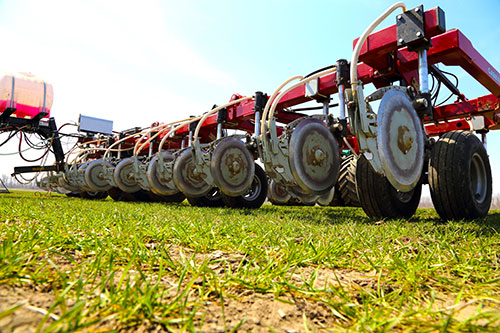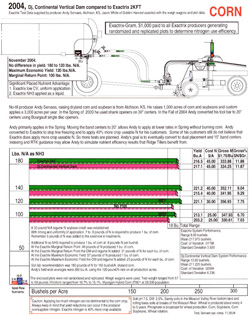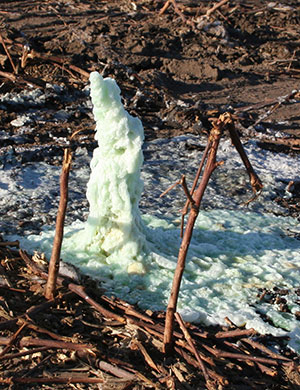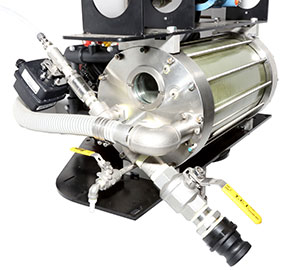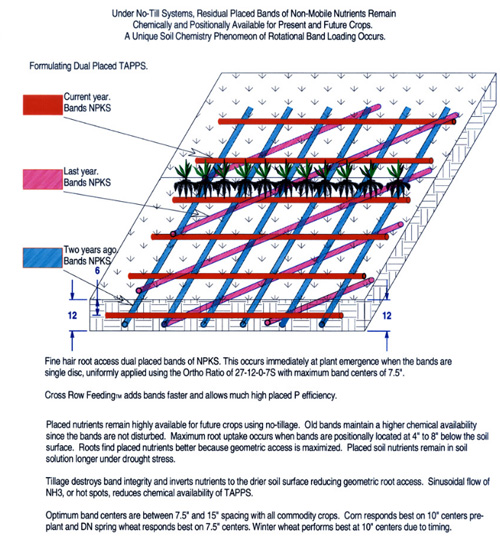Not
all fertilizer works the same.... A scientific review of Exactrix.....
The Benefits of Exactrix Superior Application Accuracy by Bert
Bock.
Benefits
of Exactrix® Superior Application Uniformity vs. Conventional
Ammonia and Granular Fertilizer Application Systems
One of the
hallmarks of Exactrix systems is application uniformity for
anhydrous ammonia and liquid fertilizers. That includes
application uniformity among openers and along each opener path.
For anhydrous ammonia, this two-way uniformity is achieved by
maintaining the ammonia as a high-pressure liquid (350 psi) rather
than a mixture liquid and gas both in the manifold and in the
distribution lines between the manifold and openers. High
pressure (350 psi) is used to achieve uniform application of
liquid fertilizers.
With Exactrix systems, anhydrous ammonia application rates for
individual openers vary on average 1 to 3 percent from the average
application rate for all openers (Figure 1). This is referred to
as the coefficient of variation (CV). This is far superior to
traditional anhydrous ammonia application systems which often have
CVs from opener-to-opener in the 20% range or higher and provide a
pulsating (sinusoidal) application rate along opener paths as
illustrated in Figure3.
Exactrix systems are also superior to granular fertilizer systems
(spinner and pneumatic) that often have CVs in the 20% range or
higher, especially with higher application rates and wider
application widths (1, 2, 3, 4). Uniformity of granule
application is affected by many factors, including particle size,
field slope, and field roughness over which the operator has
little control. These factors don't affect uniformity of
application with Exactrix systems.
Non-uniform
application not only causes some plants to be over-fertilized and
some plants to be under-fertilized. The over-fertilized hot spots
are more susceptible to gaseous ammonia moving to the soil surface
and being lost to the atmosphere. Over-fertilized hot spots can
also prevent timely access of plant roots to nutrients in the
bands and can increase the probability of seedling damage.
What does this large Exactrix application uniformity advantage
mean relative to yield when growers are striving to maximize
fertilizer use efficiency? The inference from the study
summarized below is that Exactrix application uniformity can
provide a yield advantage of several bushels per acre compared
with application uniformity provided by conventional anhydrous
ammonia and granular fertilizer systems. This is in addition to
improvements in yield and fertilizer use efficiency related to
co-injection of N, P, K, and S vs. surface application, especially
in no-till systems.

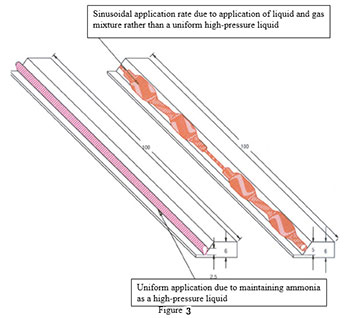
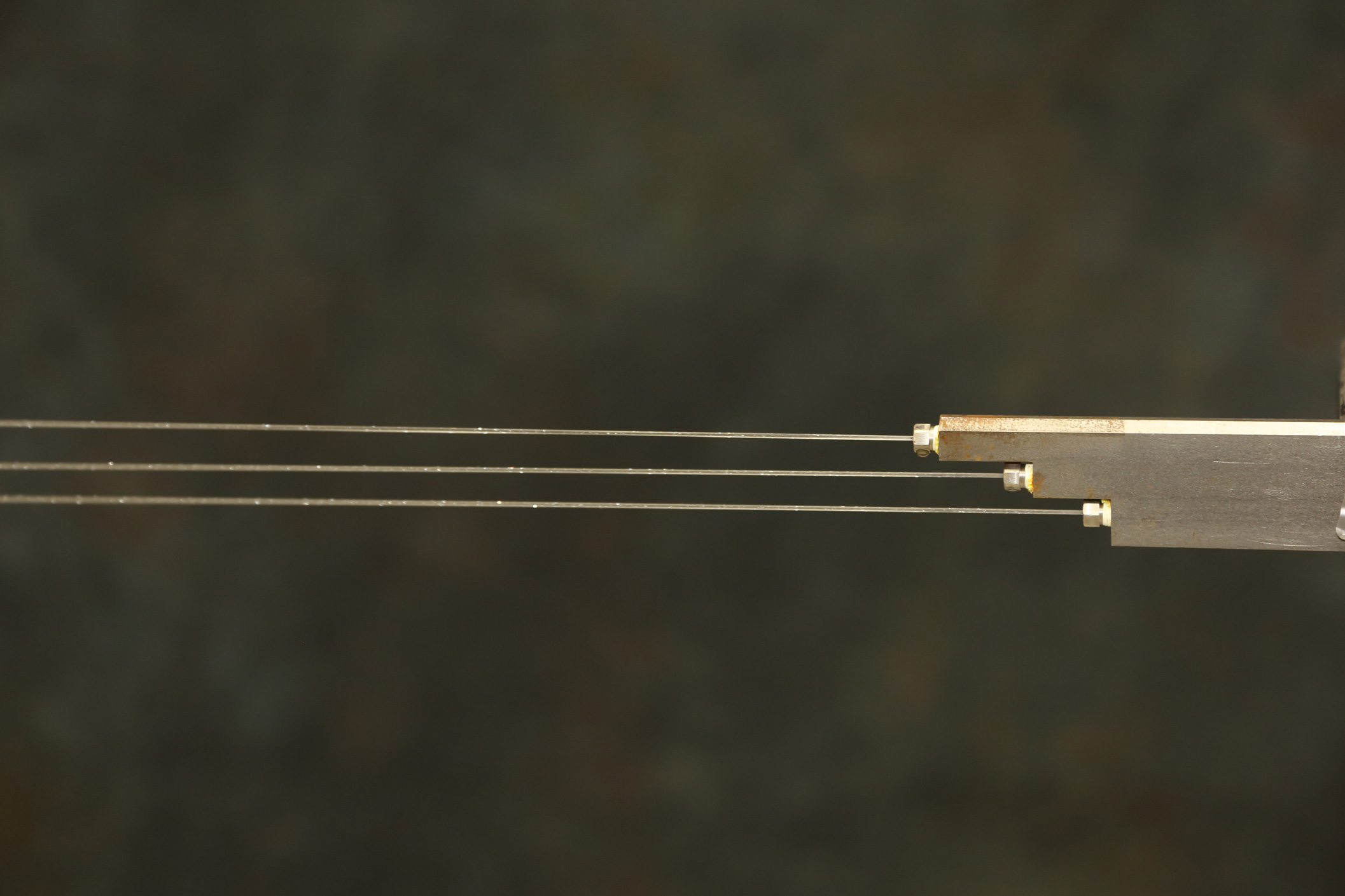
Figure
2 - High-pressure liquid anhydrous ammonia and fluid
fertilizers exit Exactrix openers at high velocity.
There are few
studies that have measured effects of fertilizer application
uniformity or non-uniformity on yields in the field. Some
theoretical studies show little effect of non-uniform
fertilizer application on yields but more credible evidence
is provided from actual measurements in the field. Kansas
State University conducted a field study comparing corn
yield with two anhydrous ammonia application systems, one
with a CV of 19% and one with a CV of 9% as determined in a
stationary test (5). Test results from the stationary
systems with ammonia captured in water cans are presented in
Table 1.
The stationary system with a 19% CV used a commercial
variable diameter orifice (VDO) controller and the
stationary system with 9% CV used a prototype pulse width
modulation (PWM) controller. In addition to giving less
uniformity of distribution among openers, the VDO controller
under-applied ammonia on average (22.3 vs. 27.0 lb ammonia
per opener during the stationary test. This was corrected
for the plot studies.
In a field trial, plots 8
rows wide and 400 ft. long were established with no N
applied and with 120 lb N/Ac applied at V8 stage using the
DVO and PWM controllers. Soil ammonium N + nitrate N levels
were measured soon after application at four 30-foot
intervals along each opener path. Grain yield was also
measured based on three mature plants collected near each
soil sampling site.
Soil ammonium
N + nitrate N levels are presented in Table 2. The CV for
soil ammonium N + nitrate N from the VDO controller was
55.6% vs. 16.8% from the PWM controller and the ranges were
22 to 216 ppm from the VDO controller and 61 to 140 ppm from
the PWM controller. This is much greater variability than
measured in the stationary applicator tests. This likely is
due partly to greater application variability with a mobile
applicator and partly to variability in soil N levels.
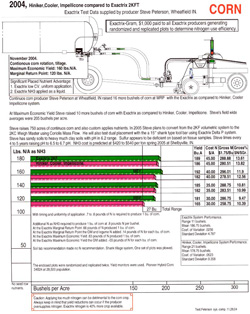
|
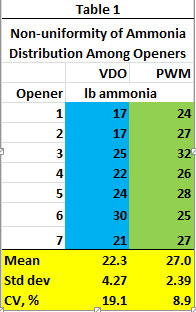 |
In a
field trial, plots 8 rows wide and 400 ft. long were
established with no N applied and with 120 lb N/Ac applied
at V8 stage using the DVO and PWM controllers.
Soil ammonium N + nitrate N levels were measured
soon after application at four 30-foot intervals along
each opener path. Grain
yield was also measured based on three mature plants
collected near each soil sampling site.
Soil
ammonium N + nitrate N levels are presented in Table 2.
The CV for soil ammonium N + nitrate N from the VDO
controller was 55.6% vs. 16.8% from the PWM controller and
the ranges were 22 to 216 ppm from the VDO controller and
61 to 140 ppm from the PWM controller.
This is much greater variability than measured in
the stationary applicator tests.
This likely is due partly to greater application
variability with a mobile applicator and partly to
variability in soil N levels.
|
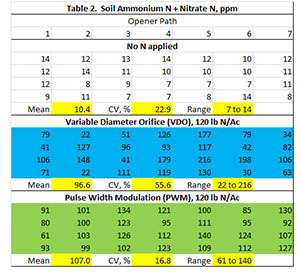 |
Grain yield was
not nearly as variable as the soil ammonium N + nitrate N
levels (Table 3). This is likely due to roots from
individual plants exploring a large enough area to take up N
from soil supplying differing amounts of N and providing
some averaging across soil N levels. Even so, the yield CV
was 17.2% for the DVO controller and 12.2 % for the PWM
controller. The yield range was 102 to 186 bu/Ac for the
DVO controller and 120 to188 bu/Ac for the PWM controller.
More importantly, the average yield based on the three plant
samples near each soil sample location was 149.4 bu/Ac for
the DVO controller and 154.5 bu/Ac for the PWM controller.
|
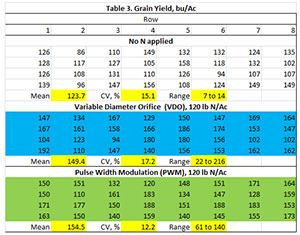 |
In another field
trial, ear leaf N at silking and grain yields were
determined based on whole-plot measurements (Table 4).
Treatments included no applied N, and N applied with VDO and
PWM controllers at 60 and 120 lb N/Ac. At the 120 lb N/Ac
rate, grain yield with the PWM controller was 9 bu/Ac higher
than with the VDO controller. At the 120 lb N/Ac rate, ear
leaf N was 0.38 percentage points higher with the PWM
controller than the DVO controller. There was clearly
significantly more N available to plants with the PWM
controller than the DVO controller.
|
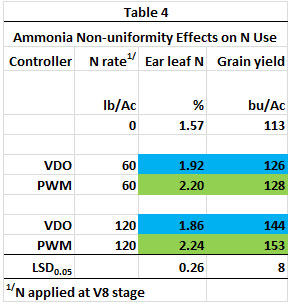 |
What do these
results imply for yield benefits from Exactrix application
uniformity? Keep in mind that conventional anhydrous
ammonia and granular fertilizer application systems have
CVs of around 20% or higher and are expected to perform
roughly the same or worse than the DVO controller in terms
of uniformity of application. Alternatively, Exactrix
systems have CVs between 1 and 3% and are expected to
perform better than the PMW controller in the study
summarized above.
Furthermore, Exactrix systems are not adversely affected
by changes in factors such as environmental conditions,
field slope, field roughness, and granule properties.
Therefore, the yield advantage from Exactrix application
uniformity is projected to be greater than the yield
difference for the two ammonia systems in the study
summarized above.
The inference from the study summarized above is that when
producers are striving to maximize fertilizer use
efficiency, Exactrix application uniformity can provide a
yield advantage of several bushels per acre compared with
application uniformity provided by conventional anhydrous
ammonia and granular fertilizer systems.
The two embedded reports
from Exactrix field trials support this conclusion.
Don't forget to add
application uniformity to your list of Exactrix benefits
when calculating your bottom line. Plant roots and
nitrogen mobility can provide some "averaging" to
partially compensate for non-uniformity of fertilizer
application; however, Exactrix systems can provide
significant yield increases related to better application
uniformity than provided with conventional anhydrous
ammonia and granular fertilizer application systems. This
is in addition to improvements in yield and fertilizer use
efficiency related to co-injection of N, P, K, and S vs.
surface application, especially in no-till systems.
|
|


